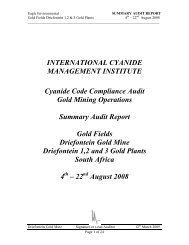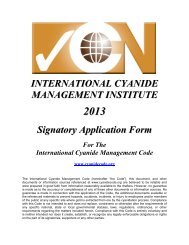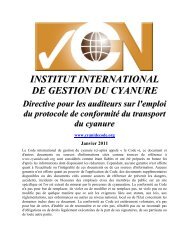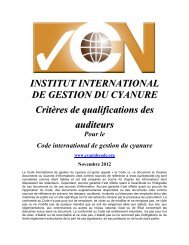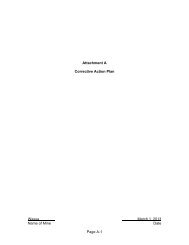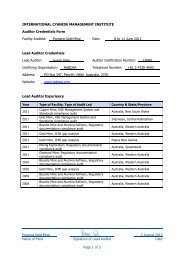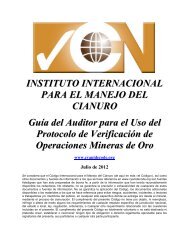Summary Audit Report - International Cyanide Management Code
Summary Audit Report - International Cyanide Management Code
Summary Audit Report - International Cyanide Management Code
Create successful ePaper yourself
Turn your PDF publications into a flip-book with our unique Google optimized e-Paper software.
ICMC <strong>Summary</strong> <strong>Audit</strong> <strong>Report</strong>Name andLocation ofOperation:<strong>Audit</strong> Scope:Name and contactinformation forCompanyContact:Cyanco Company, L.L.C.5505 Cyanco DriveWinnemucca, NV 89445Production of Sodium <strong>Cyanide</strong> Solution for the Gold Mining IndustryGreg MitchV.P. of Operations and Plant ManagerTel: (775) 623-1214 ext.101greg.mitch@cyanco.comSteve CochraneManager – Sales, Health & SafetyTel: (775) 623-1214 ext.131steve.cochrane@cyanco.comCyanco – Winnemucca <strong>Cyanide</strong> Production April 15, 2013Name of Facility Lead <strong>Audit</strong>or Datewww.mss-team.com Page 1 of 14
ICMC <strong>Summary</strong> <strong>Audit</strong> <strong>Report</strong>Company Background Information:Cyanco has production facilities in Winnemucca, Nevada and Alvin, Texas. Cyanco also hasterminal operations in Cadillac, Quebec, as well as offices in Montreal, Quebec and Reno,Nevada (corporate office).Cyanco was originally certified to the <strong>International</strong> <strong>Cyanide</strong> <strong>Management</strong> <strong>Code</strong> (ICMC) as aSignatory Production Operation in October 2006. A re-certification audit was performed in 2009and this audit was the second ICMC re-certification audit at the facility.Description of the Operations:Cyanco started producing liquid sodium cyanide in Winnemucca, Nevada in 1990 and operationswere significantly expanded 1997. Cyanco’s liquid sodium cyanide production facility is locatedapproximately 7 miles west of Winnemucca Nevada. Cyanco also started producing solid sodiumcyanide at a new production facility in Alvin, Texas in 2012. This re-certification audit is limitedin scope to the Winnemucca liquid cyanide solution production facility.The plant produces approximately a 30% sodium cyanide solution using the Andrussow process.Oxygen, methane, and ammonia are combined over a platinum catalyst where they formhydrogen cyanide gas (HCN). The HCN gas is then scrubbed using sodium hydroxide (50%caustic soda) to form liquid sodium cyanide.The product is delivered to gold mining customers in the western US in bulk delivery tankers.Since the last re-certification audit the operation has also started shipping product by rail tocustomers in Canada and Mexico. Cyanco contracts the truck delivery of the cyanide solution tothe TransWood Winnemucca Terminal, a certified ICMC Signatory Company. The terminal islocated just several miles from the production facility.This operation was confirmed to be in FULL COMPLIANCE with the <strong>International</strong> <strong>Cyanide</strong><strong>Management</strong> <strong>Code</strong>.Cyanco – Winnemucca <strong>Cyanide</strong> Production April 15, 2013Name of Facility Lead <strong>Audit</strong>or Datewww.mss-team.com Page 2 of 14
ICMC <strong>Summary</strong> <strong>Audit</strong> <strong>Report</strong><strong>Audit</strong>or’s FindingThis operation is in full compliance with the <strong>International</strong> <strong>Cyanide</strong> <strong>Management</strong> <strong>Code</strong>.This operation has not experienced any significant cyanide incidents, releases, exposures, orproblems with ICMC compliance since the previous ICMC audit. Cyanco did experience aminor air release at the beginning of 2010 and a minor release to ground at the beginning of2011. Incident investigation and corrective action records were evaluated during this audit. Therewere no releases of cyanide in the 12 months prior to the ICMC audit. Corrective actions taken inresponse to the two releases noted here were found to be effective.The operation was found to be in full ICMC compliance.<strong>Audit</strong> Company:MSS <strong>Code</strong> Certification Service, a Division of <strong>Management</strong>System Solutions, Inc.www.mss-team.com<strong>Audit</strong> Team Leader:Nicole JurczykE-mail: <strong>Code</strong><strong>Audit</strong>s@mss-team.comDate(s) of <strong>Audit</strong>: January 14-16, 2013I attest that I meet the criteria for knowledge, experience and conflict of interest for <strong>Code</strong>Verification <strong>Audit</strong> Team Leader, established by the <strong>International</strong> <strong>Cyanide</strong> <strong>Management</strong> Instituteand that all members of the audit team meet the applicable criteria established by the<strong>International</strong> <strong>Cyanide</strong> <strong>Management</strong> Institute for <strong>Code</strong> Verification <strong>Audit</strong>ors.I attest that this <strong>Summary</strong> <strong>Audit</strong> <strong>Report</strong> accurately describes the findings of the verificationaudit. I further attest that the verification audit was conducted in a professional manner inaccordance with the <strong>International</strong> <strong>Cyanide</strong> <strong>Management</strong> <strong>Code</strong> Verification Protocol for <strong>Cyanide</strong>Production Operations and using standard and accepted practices for health, safety andenvironmental audits.________________________Signature of Lead <strong>Audit</strong>orCyanco – Winnemucca <strong>Cyanide</strong> Production April 15, 2013Name of Facility Lead <strong>Audit</strong>or Datewww.mss-team.com Page 3 of 14
ICMC <strong>Summary</strong> <strong>Audit</strong> <strong>Report</strong>Production Practice 1.2: Develop and implement plans and procedures to operate cyanideproduction facilities in a manner that prevents accidental releases.The operation is in full compliance with Production Practice 1.2Summarize the basis for this Finding:Cyanco uses a document control system to manage its procedures and ensure that they areavailable to all personnel. Cyanco procedures define how the facility is to be operated in a safeand environmentally sound manner. Procedures for upset and contingency conditions are alsomaintained and are available at the point of use. Standard operating procedures are used tosystematically shut-down the two production plants if there is an upset condition. Operationspersonnel were interviewed and their awareness level of emergency and contingency procedureswas very good. The control room is manned at all times. Procedures are available in the controlroom in electronic and hard copy.An MOC process is used to manage the change to any part of the operation that contains cyanide.Records were reviewed and were found to be acceptable for changes made to the cyanide processequipment since 2009. Process equipment, tanks, and piping that contain cyanide are included inthe mechanical integrity program. Maintenance instructions are maintained in a database that isused to manage work orders. Although some maintenance records were initially unavailable inthe database, this problem was resolved shortly after the audit. Upon further review, the auditorwas able to confirm that necessary maintenance and calibration tasks are being performed by theoperation. The auditor sampled records from scheduled maintenance activities, thickness testing,and calibrations. Records were found to be acceptable.The Cyanco facility is designed to be a “zero discharge” facility, meaning that no process wateror water collected in the secondary containment areas can be discharged to the environment. Allprocess, loading, and storage equipment is in lined concrete secondary containment areas that areequipped with lined concrete or stainless steel sump pit systems. The sumps are piped into a tankthat is specifically designated to accept water from the sumps and pipe clean-outs. The cyanidecontainingwater is mixed back into the process.Sound procedures are used for the disposal of cyanide and cyanide-contaminated solids. Allcyanide is stored in outdoor tanks. The tanks have air vents to the atmosphere. Atmosphericmonitoring is done in accordance with air permit requirements to ensure that atmospheric levelsremain within permitted levels. Permitted air emissions were exceeded once since the previousICMC re-certification audit. The cause of the release was determined and process equipmentwas modified to resolve the problem. The facility has not had another atmospheric cyaniderelease since this event at the beginning of 2010.Cyanco – Winnemucca <strong>Cyanide</strong> Production April 15, 2013Name of Facility Lead <strong>Audit</strong>or Datewww.mss-team.com Page 5 of 14
ICMC <strong>Summary</strong> <strong>Audit</strong> <strong>Report</strong>The cyanide solution is maintained at a pH of ≈12.8 to limit off-gassing. Storage tanks andprocess equipment are designed to prevent the intrusion of rain water into the system or into anystorage unit not designated for the management of rain water. The site has a secure perimeter andaccess is prohibited. Packaging is not used by this operation; the cyanide solution is only shippedto customers via DOT (Department of Transportation) approved tanker trucks and FRA (FederalRailroad Administration) approved railcars that are specifically designed for this type oftransport. Proper placards are used and proper weight limits are observed for all jurisdictionsthrough which the trucks must pass.Production Practice 1.3: Inspect cyanide production facilities to ensure their integrity andprevent accidental releases.The operation is in full compliance with Production Practice 1.3Summarize the basis for this Finding:The auditor was able to confirm that tanks, valves, pipelines, and secondary containment areasare routinely inspected for their integrity, closure of valves, presence of fluids, and deterioration.Operators were interviewed and the inspection sheets from field rounds and sump / draininspections were reviewed. Tanks, pipes, and process equipment are visually inspected on aquarterly basis. Inspection records were sampled for 2010, 2011, and 2012. Additionally, visualand thickness testing inspections of process equipment, tanks, and piping containing cyanide areperformed according to API (American Piping Institute) guidance at defined frequencies as partof the mechanical integrity program. Thickness testing records were sampled for tanks, pressurevessels, and piping.Inspection frequencies were deemed to be sufficient to assure that equipment is functioningwithin design parameters. In addition to regular inspections, equipment shut downs withextensive maintenance activities are conducted at least annually.Inspections are documented and show the date of the inspection, the name of the inspector, andany observed deficiencies. An overall action list is generated from the quarterly equipmentinspections. Issues that are readily resolved are noted as such on the inspection report. Workorders are opened for issues that require corrective maintenance actions. Inspection records andrecords of resulting corrective measures were reviewed and were found to be acceptable.Cyanco – Winnemucca <strong>Cyanide</strong> Production April 15, 2013Name of Facility Lead <strong>Audit</strong>or Datewww.mss-team.com Page 6 of 14
ICMC <strong>Summary</strong> <strong>Audit</strong> <strong>Report</strong>2. WORKER SAFETY: Protect workers’ health and safety from exposure to cyanide.Production Practice 2.1: Develop and implement procedures to protect plant personnel fromexposure to cyanide.The operation is in full compliance with Production Practice 2.1Summarize the basis for this Finding:Worker exposure to cyanide is minimized through properly engineered systems, the use ofdetailed standard operating procedures, and proper use of personal protective equipment (PPE)where necessary. The minimum PPE requirements are defined in each procedure. Operators,maintenance personnel, and laboratory personnel were interviewed. Personnel showed goodawareness of PPE requirements associated with different types of tasks. Emergency proceduresare defined in the site emergency response plan. Maintenance procedures exist for repetitivetasks that have the potential for worker exposure to cyanide. PPE requirements and safetyprecautions are defined. Hazardous and non-routine tasks such as confined space entry requirethe use of work permits to ensure that they are performed safely.<strong>Management</strong> of Change (MOC) and Pre-Start-Up-Safety Review (PSSR) procedures are used toevaluate the potential safety, health, and environmental impact of proposed and implementedoperational changes and modifications. Operators, engineers, and EHS personnel are involved inthe management of change process and in the PSSRs. They are also involved in process hazardanalyses (PHAs).Stationary HCN monitors are used in indoor areas that have the potential for having elevatedcyanide levels and personal HCN monitors are used by employees for tasks that have thepotential for cyanide exposure. The stationary monitors and the personal monitors are part of thecomputerized maintenance system to ensure that they are maintained, tested, and calibrated on amonthly basis. Although records were available to show that necessary calibrations had beencompleted since the 2009 ICMC audit, the auditor noted that improvements in the calibrationprogram were necessary. Shortly after the on-site audit Cyanco improved its practices used forcalibration record-keeping, procedural descriptions, and training methods. All improvementswere fully evaluated by the auditor and were found to be effective. The audit finding was closedwith no further corrective actions required.Operations where the risk of cyanide exposure may be elevated have been identified and PPErequirements have been defined. PPE requirements are clearly defined for all tasks and enclosedspaces in which cyanide is handled (laboratory and a sampling building) have stationary HCNmonitors that are monitored by the control room operator. Atmospheric levels of HCN gas areCyanco – Winnemucca <strong>Cyanide</strong> Production April 15, 2013Name of Facility Lead <strong>Audit</strong>or Datewww.mss-team.com Page 7 of 14
ICMC <strong>Summary</strong> <strong>Audit</strong> <strong>Report</strong>tested prior to any confined space entry or similar maintenance activity. Work permits are usedfor these types of tasks to ensure that the area is safe and that proper PPE is being utilized. Thehazardous work / line break work permit process was improved in 2010 following a minorrelease of HCN gas during a maintenance operation. The improved practice calls for the signingManager to personally walk through each permitted task area before signing the work permit andallowing the task to be performed and/or completed. This appears to be an effective process.Several permitted maintenance operations were observed during the audit. <strong>Management</strong>personnel provided a high level of oversight to the completion of all permitted maintenance workobserved during the audit.The buddy system is used for all tasks that are potentially hazardous. Employees’ health isevaluated upon hire and periodically thereafter. Health exams are used to evaluate the employeegeneral health and confirm fitness for duty. The clothing change policy for employee is detailedin the Safety Manual and in a Personal Protection Procedure. Employees are issued uniformsthat must stay at Cyanco. Clothing is washed on-site.Visitor PPE requirements are stated on the Visitor Registration form, which is signed by thevisitor upon arrival at the site.The operation has posted signs that limit access to the production area and requires that visitorsenter through the main office. PPE signs were also visible. Signs warning of potential hazardsdue to the presence of cyanide were also posted. Eating, drinking, smoking, and open flames areprohibited where there is a potential for cyanide contamination. Employees showed very goodawareness of the restrictions and of the potential dangers of not following the rules. Eating isallowed in a designated lunchroom area and in offices. Significant improvements were made tothe facility since the previous audit. The office area was increased, a driver lounge was built,clothing changing facilities were enlarged and improved, and a larger lunch room that is on adifferent floor from the control room and other work areas was added. Smoking is restricted to adesignated smoking area.Production Practice 2.2: Develop and implement plans and procedures for rapid and effectiveresponse to cyanide exposure.The operation is in full compliance with Production Practice 2.2Summarize the basis for this Finding:Cyanco maintains a comprehensive Emergency Response Plan. The plan is reviewed regularlywith its most recent revision occurring in 2012. Industrial combination shower / low-pressure eyewash stations are located throughout the facility. ABC dry chemical fire extinguishers arelocated in production areas and any areas that potentially have cyanide in them. Safety showersCyanco – Winnemucca <strong>Cyanide</strong> Production April 15, 2013Name of Facility Lead <strong>Audit</strong>or Datewww.mss-team.com Page 8 of 14
ICMC <strong>Summary</strong> <strong>Audit</strong> <strong>Report</strong>and Eyewash stations are tested weekly. Fire extinguishers and fire suppression systems aretested monthly. The facility has water, oxygen, resuscitator, antidote and a means ofcommunication readily available at strategic points in the plant. Emergency equipment isinspected on a monthly basis as part of the general housekeeping and safety inspection process.Emergency response equipment is stored and tested according to manufacturer’srecommendations. <strong>Cyanide</strong> antidote medicine is stored centrally in the control room. MaterialSafety Data Sheets (MSDSs) and first aid procedures on cyanide are available to workers.MSDSs are available in the control room and on the company intranet. First aid procedures arecontained in the Emergency Response Plan. Storage tanks, process tanks, containers and pipingcontaining cyanide are properly identified to alert employees of their contents. All pipingobserved during the audit was very well marked and showed the direction of flow.Decontamination procedures for employees and contractors are outlined in formal procedures.<strong>Cyanide</strong> safety training is given annually and employees and supervisors demonstrated a verygood understanding of the decontamination policy and the need for to take safety precautions.The plant has an emergency response team that provides first aid assistance to workers who maybe exposed to cyanide. The Emergency Response Plan calls for the decontamination of a cyanideexposure victim prior to transport. Communications between plant personnel and the localcommunity are very strong and formal communications are sent out to the local hospital everytwo years. The operation is located in a mining community and local hospitals and emergencypersonnel are qualified for treating cyanide exposure victims. The operation conducts mockemergency drills, holds a drill critique, and evaluates the need for further training or adjustmentto the emergency procedures each year. Full incident investigation reports are filled out in theevent that one occurs. Records were available to show involvement of management,identification of root cause factors, and implementation of recommendations.3. MONITORING: Ensure that process controls are protective of the environment.Production Practice 3.1: Conduct environmental monitoring to confirm that planned orunplanned releases of cyanide do not result in adverse impacts.The operation is in full compliance with Production Practice 3.1Summarize the basis for this Finding:The facility does not discharge directly or indirectly to surface water. The nearest surface wateris a river that is located about one mile south of the plant. The operation is a “zero discharge”facility. Groundwater is monitored up-gradient and down-gradient of the site as per permitrequirements. No cyanide has been detected in groundwater.Cyanco – Winnemucca <strong>Cyanide</strong> Production April 15, 2013Name of Facility Lead <strong>Audit</strong>or Datewww.mss-team.com Page 9 of 14
ICMC <strong>Summary</strong> <strong>Audit</strong> <strong>Report</strong>There was one reportable cyanide release to ground at the beginning of 2011 due to an incidentduring the loading of a truck. Although interlocks in the truck loading process functioned asdesigned, the product that was in the hose was unable to be contained and went to ground.Authorities were notified, the soil was excavated and remediated, and extensive environmentaltesting was performed. Cyanco confirmed through third-party environmental testing that therehad been no impact to groundwater and that all residue cyanide had been completely remediated.The incident was investigated and corrective actions including the installation of additionalinterlocks at the truck loading station were implemented. The corrective actions were evaluatedduring this audit and were found to be effective.Stationary atmospheric cyanide monitors are used to perform air monitoring at the site perimeter,as required by the site air quality permit. Calculations are used to determine the amount ofcyanide released to the environment. Since the previous ICMC audit there was one minor HCNair release in 2010 that occurred during a maintenance activity. The incident was thoroughlyinvestigated and corrective actions to address the root cause of the problem were taken. Theseactions were evaluated during this audit and were found to be effective. No other air permitexcursions have happened since 2010. Air and groundwater monitoring is done in accordancewith state permitting requirements and was found to be appropriate.4. TRAINING: Train workers and emergency response personnel to manage cyanide in asafe and environmentally protective manner.Production Practice 4.1:Train employees to operate the plant in a manner that minimizesthe potential for cyanide exposures and releases.The operation is in full compliance with Production Practice 4.1Summarize the basis for this Finding:Cyanco has a formal training program that includes cyanide safety training prior to the start ofwork and annual refresher training. The training program discusses cyanide hazards and safetyprecautions. The training program is very well organized and records are maintained in hardcopy and electronic format. Training records, including completed tests, were sampled for theyears 2010 through 2012. Safety training records were readily available and complete.Personnel are trained on the use of personal protective equipment as part of the safety trainingand again during the on-the-job training done by supervisors. Employees are trained to performnormal production tasks to minimize risks to personal safety and the environment. Eachprocedure has a test associated with it and employees who use the procedure are required todemonstrate competency through testing. A training curriculum exists for each job type.Experienced employees, professional trainers, or supervisors administer training to employees.The operation requires extensive training prior to allowing employees to work with cyanide. TheCyanco – Winnemucca <strong>Cyanide</strong> Production April 15, 2013Name of Facility Lead <strong>Audit</strong>or Datewww.mss-team.com Page 10 of 14
ICMC <strong>Summary</strong> <strong>Audit</strong> <strong>Report</strong>effectiveness of the cyanide training is confirmed through testing and through observation by aqualified person.Production Practice 4.2: Train employees to respond to cyanide exposures and releases.The operation is in full compliance with Production Practice 4.2Summarize the basis for this Finding:Employees are trained on what to do if a cyanide release is discovered. This is part of thecyanide safety training and the training on the emergency response plan. Employees are trainedon how to respond to a worker exposure to cyanide and drills are conducted annually to ensurethat the Emergency Response Team refreshes its skills. Corrective actions are processed andemergency procedures are revised as necessary following drill critiques. Training records aremaintained in each employee file. Records are maintained for at least as long as the employee isworking at the site. Records were sampled for 2010, 2011, and 2012. All records pertaining tocyanide safety were sufficiently detailed to be found compliant to ICMC and internalrequirements.5. EMERGENCY RESPONSE: Protect communities and the environment through thedevelopment of emergency response strategies andcapabilities.Production Practice 5.1: Prepare detailed emergency response plans for potential cyanidereleases.The operation is in full compliance with Production Practice 5.1Summarize the basis for this Finding:The Emergency Response Plan (ERP) was reviewed and was found to be appropriate for theoperation. The ERP is reviewed and updated at least annually. The last revision was made in2012. Potential failure scenarios considered in the ERP include atmospheric release of hydrogencyanide, release of solutions during truck loading, releases during fire, releases due to tank andpipe ruptures, power outages, and overtopping of tanks. The emergency response plan fulfillsICMC requirements.Cyanco – Winnemucca <strong>Cyanide</strong> Production April 15, 2013Name of Facility Lead <strong>Audit</strong>or Datewww.mss-team.com Page 11 of 14
ICMC <strong>Summary</strong> <strong>Audit</strong> <strong>Report</strong>Production Practice 5.2:Involve site personnel and stakeholders in the planning process.The operation is in full compliance with Production Practice 5.2Summarize the basis for this Finding:Cyanco Environmental, Health, and Safety (EH&S) staff are involved in the Local EmergencyPlanning Committee (LEPC) in Winnemucca. The EH&S Manager regularly meets withstakeholders. Records of community and emergency planning activities were available for eachyear since the previous ICMC audit. Stakeholders included people from Humboldt General(hospital), mining customers, Humboldt County School District, Humboldt County Commission,Bureau of Land <strong>Management</strong>, and the City of Winnemucca.Cyanco employees who are part of the Emergency Response Team are also involved in theemergency planning process. Cyanco has strong communications and relationships with the cityof Winnemucca. According to interviews with the EH&S Manager, stakeholder input isincorporated into the ERP to ensure that the plan addresses any changing circumstances and/changing risks in the area. The ERP was last updated in 2012.Production Practice 5.3: Designate appropriate personnel and commit necessary equipmentand resources for emergency response.The operation is in full compliance with Production Practice 5.3Summarize the basis for this Finding:A review of the ERP confirmed that all 5.3.1 <strong>Code</strong> requirements are appropriately addressed.The Control Board Operator is the Incident Commander during any emergency until relieved bya Lead Operator or an authorized member of management. Emergency Response Team membersare designated using red font on the Quick Reference contact list sheet that is part of the ERPbinder. Call-out procedures are detailed in the plan and 24-hour contact information is on theQuick Reference sheet. Emergency Response Members also stated that all emergency numbersare programmed into their cell phones. Emergency Equipment that is necessary is listed ingeneral terms in the Emergency Response Plan and in more detailed terms in the EmergencyPreparedness Plan and the Monthly Checklist that is used to inspect the equipment. EmergencyEquipment and the Incident Command Post (ICP - mobile command post) are inspectedregularly. Records were sampled for 2010, 2011, and 2012 and were found to be complete. Mostof the equipment is maintained in two trailers that can be used either on-site or off-site.Cyanco – Winnemucca <strong>Cyanide</strong> Production April 15, 2013Name of Facility Lead <strong>Audit</strong>or Datewww.mss-team.com Page 12 of 14
ICMC <strong>Summary</strong> <strong>Audit</strong> <strong>Report</strong>Equipment was found to be well organized and in excellent condition. Call numbers for outsideresponders are contained within the plan. Cyanco participates in combined drills with thetransporter, mine sites, and local responders to ensure that roles between organizations areunderstood.Production Practice 5.4:notification and reporting.Develop procedures for internal and external emergencyThe operation is in full compliance with Production Practice 5.4Summarize the basis for this Finding:The ERP has a list of internal and external stakeholders that need to be notified depending on thenature of the emergency. The call lists include numbers for management, regulatory agencies,outside responders, and medical facilities. Appendix B of the ERP – Media Relations and CrisisCommunications – gives additional guidance and information with regards to communicationswith external stakeholders.Production Practice 5.5: Incorporate into response plans and remediation measuresmonitoring elements that account for the additional hazards of usingcyanide treatment chemicals.The operation is in full compliance with Production Practice 5.5Summarize the basis for this Finding:The ERP discusses the steps to be taken in the event of a cyanide release to ground or water.Neutralization of soil is discussed and the plan also lists the name and telephone number of acommercial remediation management contractor who would be called to assist with any largescaleremediation effort. The hazards experienced with a cyanide release to water are alsodiscussed in the plan. The ERP also prohibits the use of sodium hypochlorite and other treatmentchemicals in surface water.Cyanco – Winnemucca <strong>Cyanide</strong> Production April 15, 2013Name of Facility Lead <strong>Audit</strong>or Datewww.mss-team.com Page 13 of 14
ICMC <strong>Summary</strong> <strong>Audit</strong> <strong>Report</strong>Production Practice 5.6: Periodically evaluate response procedures and capabilities andrevise them as needed.The operation is in full compliance with Production Practice 5.6Summarize the basis for this Finding:Cyanco conducts emergency drills, holds drill critiques, and evaluates the need for furthertraining or adjustment to the emergency procedures each year. Records were available to showthat drills with external stakeholders were conducted in 2010, 2011, and 2012. The emergencyplans were evaluated and revised as necessary in response to drill critiques and incidents sincethe previous ICMC audit.Cyanco – Winnemucca <strong>Cyanide</strong> Production April 15, 2013Name of Facility Lead <strong>Audit</strong>or Datewww.mss-team.com Page 14 of 14






